After 14 summers excavating in Yellowstone National Park, Doug MacDonald has a simple rule of thumb. “Pretty much anywhere you’d want to pitch a tent, there are artifacts,” he says, holding up a 3,000-year-old obsidian projectile point that his team has just dug out of the ground. “Like us, Native Americans liked to camp on flat ground, close to water, with a beautiful view.”
We’re standing on a rise near the Yellowstone River, or the Elk River as most Native American tribes called it. A thin wet snow is falling in late June, and a few scattered bison are grazing in the sagebrush across the river. Apart from the road running through it, the valley probably looks much as it did 30 centuries ago, when someone chipped away at this small piece of black glassy stone until it was lethally sharp and symmetrical, then fastened it to a straightened shaft of wood and hurled it at bison with a spear-throwing tool, or atlatl.
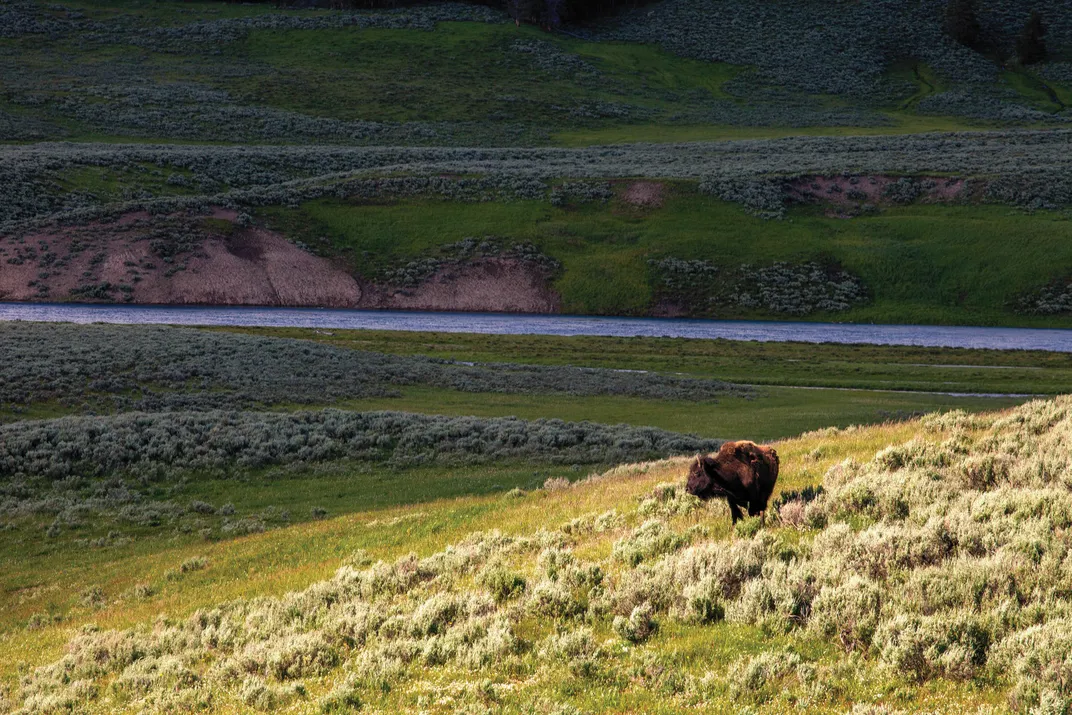
“The big myth about Yellowstone is that it’s a pristine wilderness untouched by humanity,” says MacDonald. “Native Americans were hunting and gathering here for at least 11,000 years. They were pushed out by the government after the park was established. The Army was brought in to keep them out, and the public was told that Native Americans were never here in the first place because they were afraid of the geysers.”
MacDonald is slim, clean-cut, in his early 50s. Originally from central Maine, he is a professor of anthropology at the University of Montana and the author of a recent book, Before Yellowstone: Native American Archaeology in the National Park. Drawing on his own extensive discoveries in the field, the work of previous archaeologists, the historical record and Native American oral traditions, MacDonald provides an essential account of Yellowstone’s human past. Tobin Roop, chief of cultural resources at Yellowstone, says, “As an archaeologist, working in partnership with the park, MacDonald has really opened up our understanding of the nuances and complexities of the prehistory.”
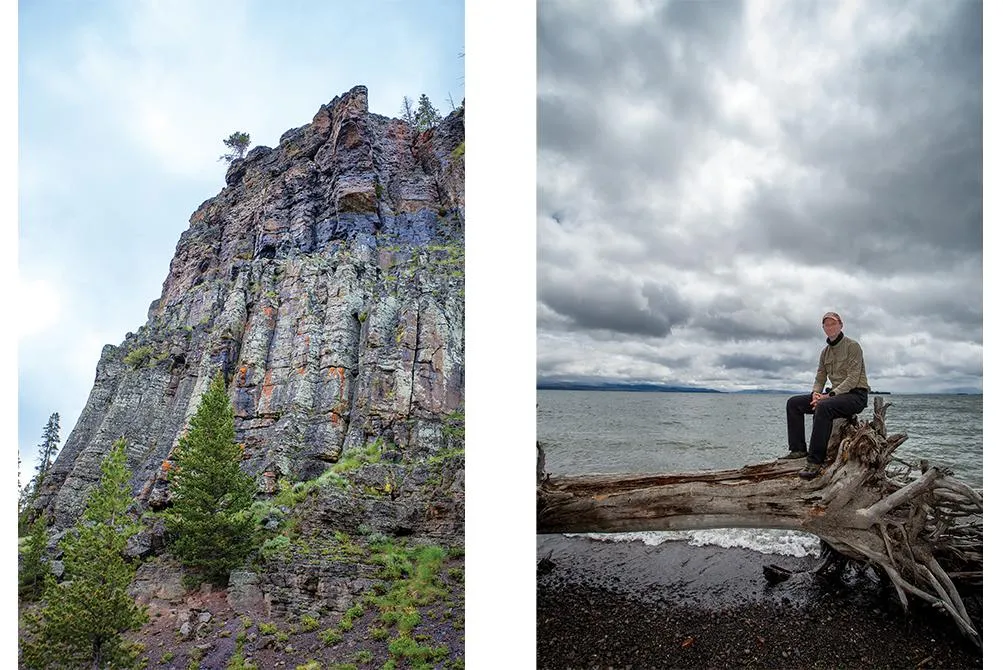
MacDonald sees his work, in part, as a moral necessity. “This is a story that was deliberately covered up and it needs to be told,” he says. “Most visitors to the park have no idea that hunter-gatherers were an integral part of this landscape for thousands of years.”
In the last three decades, the National Park Service has made substantial efforts to research and explain the Native American history and prehistory of Yellowstone, but the virgin-wilderness myth is still promoted in the brochure that every visitor receives at the park entrance: “When you watch animals in Yellowstone, you glimpse the world as it was before humans.” Asked if he considers that sentence absurd, or offensive to Native Americans, MacDonald answers with a wry smile. “Let’s just say the marketing hasn’t caught up with the research,” he says. “Humans have been in Yellowstone since the time of mammoths and mastodons.”
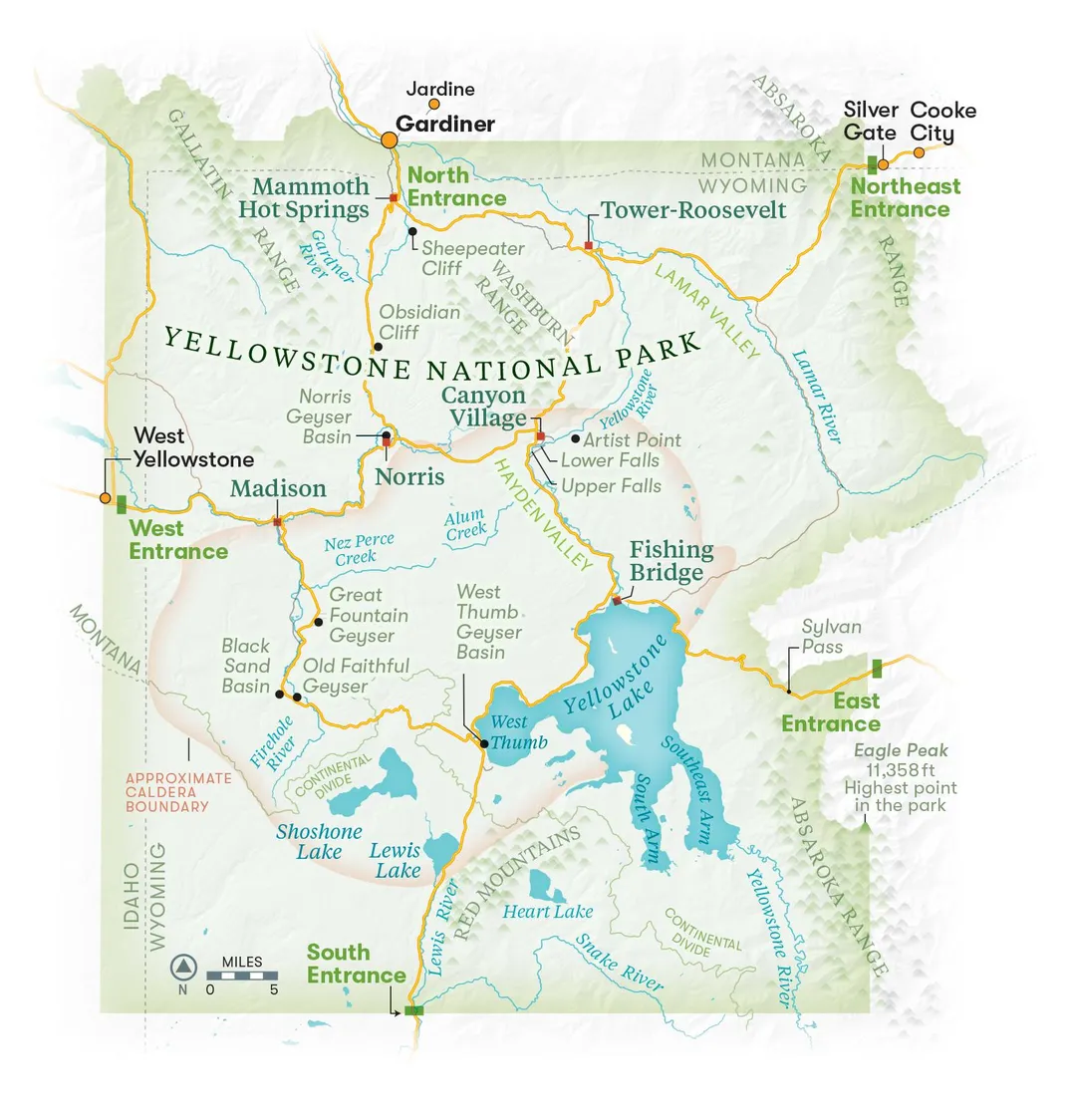
Shane Doyle, a research associate at Montana State University and a member of the Apsaalooke (Crow) Nation, burst out laughing when I read him that sentence from the brochure. But his laughter had an edge to it. “The park is a slap in the face to Native people,” he said. “There is almost no mention of the dispossession and violence that happened. We have essentially been erased from the park, and that leads to a lot of hard feelings, although we do love to go to Yellowstone and reminisce about our ancestors living there in a good way.”
* * *
On the road between the Norris Geyser Basin and Mammoth Hot Springs is a massive outcrop of dark volcanic rock known as Obsidian Cliff, closed to the public to prevent pilfering. This was the most important source in North America for high-quality obsidian, a type of volcanic glass that forms when lava cools rapidly. It yields the sharpest edge of any natural substance on earth, ten times sharper than a razor blade, and Native Americans prized it for making knives, hide-scraping tools, projectile points for spears and atlatl darts, and, after the invention of the bow and arrow 1,500 years ago, for arrowheads.

For the first people who explored the high geothermal Yellowstone plateau—the first to see Old Faithful and the other scenic wonders—Obsidian Cliff was a crucial discovery and perhaps the best reason to keep coming back. In that era, after the rapid melting of half-mile-thick glaciers that had covered the landscape, Yellowstone was a daunting place to visit. Winters were longer and harsher than they are today, and summers were wet and soggy with flooded valleys, dangerous rivers and a superabundance of mosquitoes.
MacDonald made one of the most exciting finds of his career in 2013 on the South Arm of Yellowstone Lake: a broken obsidian projectile point with a flake removed from its base in a telltale fashion. It was a Clovis point, approximately 11,000 years old and made by the earliest visitors to Yellowstone. The Clovis people (named after Clovis, New Mexico, where their distinctive, fluted points were first discovered in 1929) were hardy, fur-clad, highly successful hunters. Their prey included woolly mammoths, mastodons and other animals that would become extinct, including a bison twice the size of our modern species.
The Clovis point that MacDonald’s team spotted on the beach is one of only two ever found in the park, suggesting that the Clovis people were infrequent visitors. They preferred the lower elevation plains of present-day Wyoming and Montana, where the weather was milder and large herds of megafauna supported them for 1,000 years or more. MacDonald thinks a few bands of Clovis people lived in the valleys below the Yellowstone plateau. They would come up occasionally in the summer to harvest plants and hunt and get more obsidian.
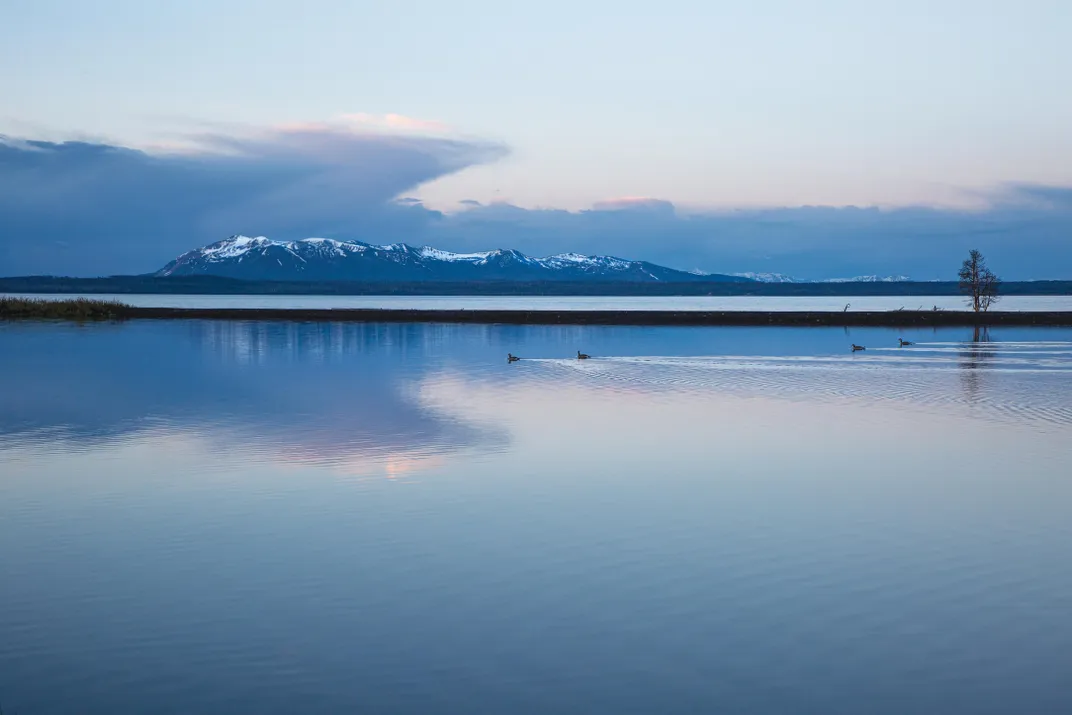
“Native Americans were the first hard-rock miners in Wyoming and it was arduous work,” says MacDonald. “We’ve found more than 50 quarry sites on Obsidian Cliff, and some of them are chest-deep pits where they dug down to get to the good obsidian, probably using the scapular blade of an elk. Obsidian comes in a cobble [sizable lump]. You have to dig that out of the ground, then break it apart and start knapping the smaller pieces. We found literally millions of obsidian flakes on the cliff, and we see them all over the park, wherever people were sitting in camp making tools.”
Each obsidian flow has its own distinctive chemical signature, which can be identified by X-ray fluorescence, a technique developed in the 1960s. Artifacts made of Yellowstone obsidian from Obsidian Cliff have been found all over the Rockies and the Great Plains, in Alberta, and as far east as Wisconsin, Michigan and Ontario. Clearly it was a valuable commodity and widely traded.
On the Scioto River south of Columbus, Ohio, archaeologists identified 300 pounds of Yellowstone obsidian in mounds built by the Hopewell people 2,000 years ago. It’s possible the obsidian was traded there by intermediaries, but MacDonald and some other archaeologists believe that groups of Hopewell made the 4,000-mile round trip, by foot and canoe, to bring back the precious stone.
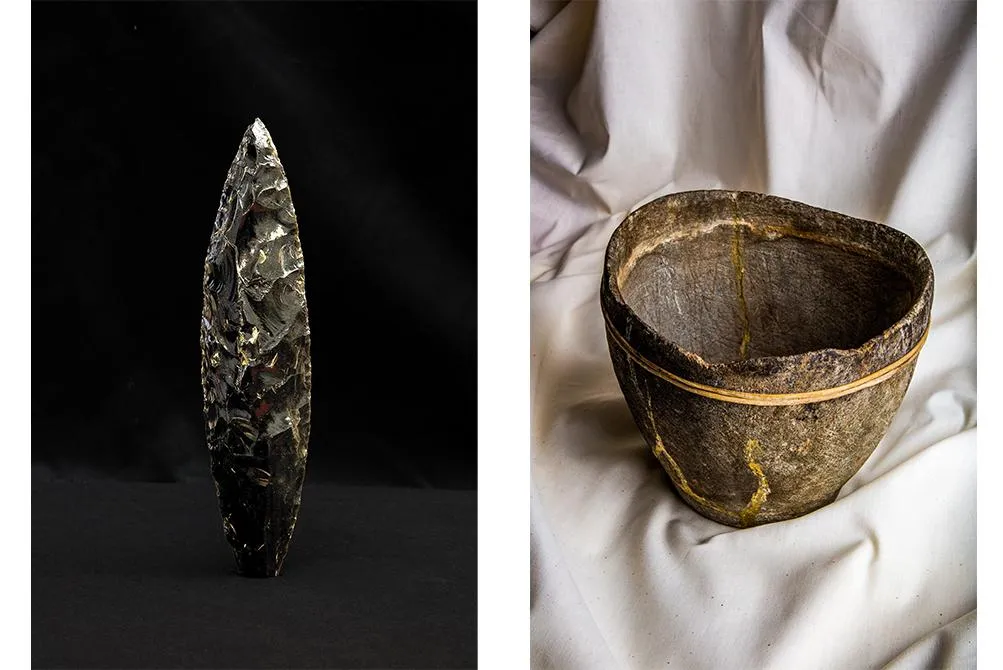
“In 2009, we found a very large ceremonial knife, typical of the Hopewell culture and unlike anything from this region, on a terrace above Yellowstone Lake,” he says. “How did it get there? It’s not far-fetched to think that it was lost by Hopewell people on a trip to Obsidian Cliff. They would have left in early spring and followed the rivers, just like Lewis and Clark, except 2,000 years earlier.”
Another tantalizing relic, found inside a Hopewell mound in Ohio, is a copper sculpture of a bighorn ram’s horn. Then as now, there were no bighorn sheep in the Midwest or the Great Plains. But if Hopewell people were making epic journeys west to get obsidian, they would have seen bighorns in the Northern Rockies, and the animals were particularly abundant in Yellowstone.
* * *
Twenty miles long and 14 miles wide, Yellowstone Lake is the largest natural high-elevation lake in North America. MacDonald describes the five summers he spent on the remote, roadless southern and eastern shores of the lake with a small crew of graduate students as “the most exciting and also the most frightening experience of my career.” Today we are standing on the northern shore, which is accessible by road. A cold wind is blowing, and the water looks like a choppy sea with spray flying off the whitecaps. “We had to use canoes to get there and load them with all our gear,” he recalls. “The water gets really rough in bad weather, much worse than you see today, and we nearly got swamped a few times. One of our crew got hypothermia. We had to build an illegal fire to save his life. Another time my guys were stalked on the beach by a cougar.”

Grizzlies are his biggest fear. MacDonald always carries bear spray in Yellowstone, never walks alone and is careful to make plenty of noise in the woods. One night at the lake, he recalls, he and his crew were eating steaks around a campfire when they saw a young grizzly bear staring at them from 200 yards. That night they heard his roars and barks echoing across the lake; they surmised that the bear was frustrated because a bigger grizzly was keeping him away from an elk carcass a quarter-mile distant.
“The next day he attacked our camp,” says MacDonald. “He peed in my tent, pooped everywhere, destroyed the fire pit, licked the grill, just trashed everything. We stayed up all night making noise, and thankfully it worked. He didn’t come back. I still have that tent and it still reeks of bear pee.”
They also had trouble from bison and bull elk that occupied their excavation sites and declined to leave. They endured torrential rains and ferocious electric storms. Once they had to evacuate in canoes because of a forest fire. “We all had the feeling that the gods wanted us out of there, and we kept finding amazing stuff. There were basically sites everywhere.”
Among their discoveries were a 6,000-year-old hearth, a Late Prehistoric stone circle (or tepee base) lying intact under a foot of dirt, and a wide variety of stone tools and projectile points. Excavating a small boulder with obsidian flakes littered around its base, they knew that someone, man or woman, boy or girl, had sat there making tools 3,000 years ago. “I think both genders knapped stone tools, because they were in such constant use and demand,” says MacDonald.
MacDonald’s team found evidence of continual human occupation on the lakeshore for 9,500 years, starting with the Cody Culture people, whose square-stemmed projectile points and asymmetrical knives were first discovered in Cody, Wyoming. More than 70 Cody points and knives have been found in Yellowstone, with the greatest concentration at the lake. “The climate was getting hotter and drier and it was cool up here in summer. As the bison migrated up to the higher elevations, Cody people almost certainly followed them.”
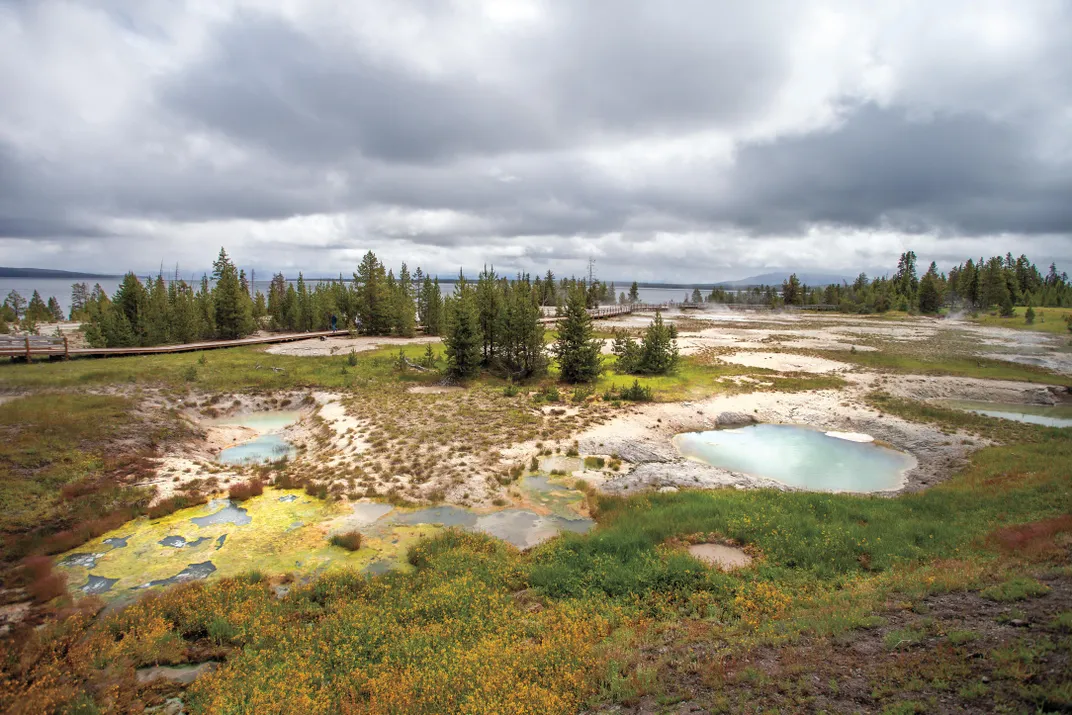
Over the following millennia, as the climate warmed, the modern bison evolved and human populations rose in the Great Plains and Rockies. Yellowstone became a favored summer destination, drawing people from hundreds of miles away, and the lakeshore was an ideal place to camp. There is no evidence of conflict among the different tribal groups; MacDonald thinks they probably traded and visited with one another.
The peak of Native American activity in Yellowstone was in the Late Archaic period, 3,000 to 1,500 years ago, but even in the 19th century it was still heavily used, with as many as ten tribes living around the lake, including Crow, Blackfeet, Flathead, Shoshone, Nez Perce and Bannock.
Today, as sedentary people, we equate “living” in a place with long-term or even permanent settlement. But for hunter-gatherers who follow animal migrations, avoid climate extremes and harvest different plants as they ripen in different areas, the word has a different meaning. They live in a place for part of the year, then leave and come back, generation after generation. One Shoshone group known as the Sheepeaters seldom left the current park boundaries, because they were able to harvest bighorn sheep year-round. But most Native Americans in Yellowstone moved down to lower, warmer elevations in winter, and returned to the high plateau in the spring. A few brave souls returned in late winter to walk on the frozen lake and hunt bears hibernating on the islands.
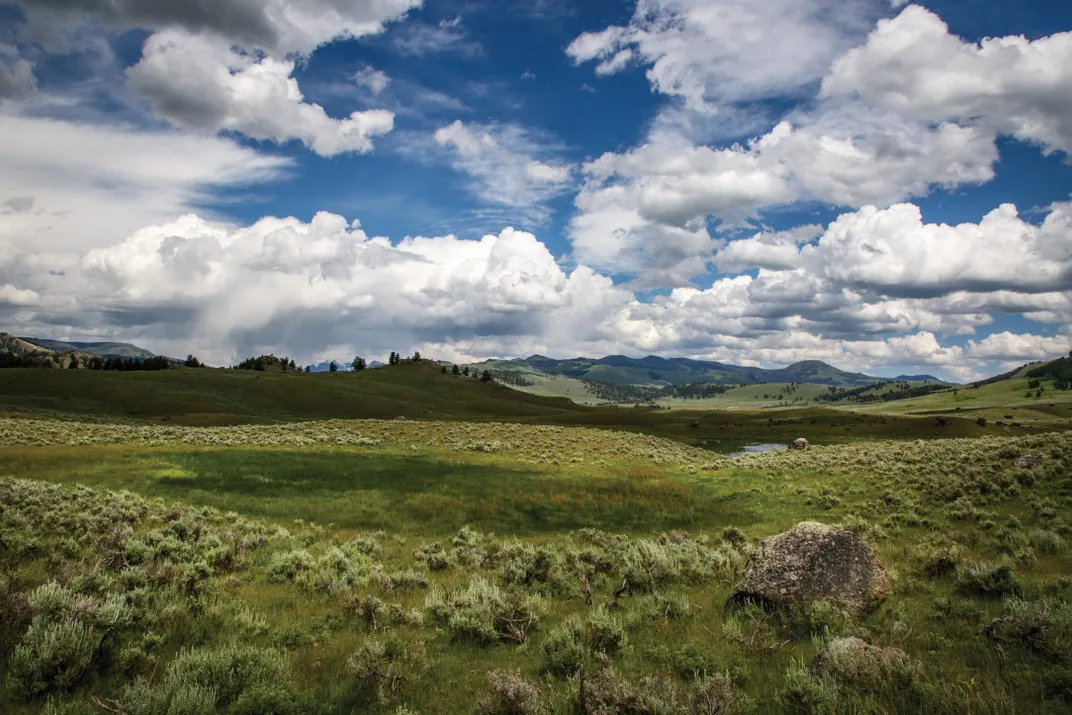
“They were probably getting the spiritual power of the animal, and demonstrating their courage, by entering the dens,” says MacDonald. “People have hunted bears that way in Siberia, Northern Europe, anywhere there’s bears. Some people still do. You can see the videos on YouTube. Young adult males are the only ones stupid enough to do it, and I imagine that was the case here too.”
* * *
When MacDonald was a freshman at Brown University, in Providence, Rhode Island, he studied political economy, international development and finance, and envisioned a career at the World Bank or the International Monetary Fund. Then he spent a couple of summers in central Mexico with friends who liked visiting archaeological sites, often traveling on third-class rural “chicken buses” to get there.
“Some of those sites were amazing, and when I got back to Brown, I started taking archaeology classes,” he says. “One of them was taught by Richard Gould, who is kind of a famous guy, and it was about hunter-gatherers. It made me realize that I didn’t want to spend my life at the World Bank. I wanted to work on the archaeology of hunter-gatherers instead.”
MacDonald has never killed his own meat and knows little about edible and medicinal plants, but he believes that hunting and gathering is the most successful way of living that humanity has ever devised. “We’re proud of our technological advances, but in historical terms our society has lasted a split second,” he says. “We lived as hunter-gatherers for three million years. We moved around in extended family groups that took care of each other. It was egalitarian because there was no wealth. It was a healthy way for humans to live and we were well adapted for it by evolution.”
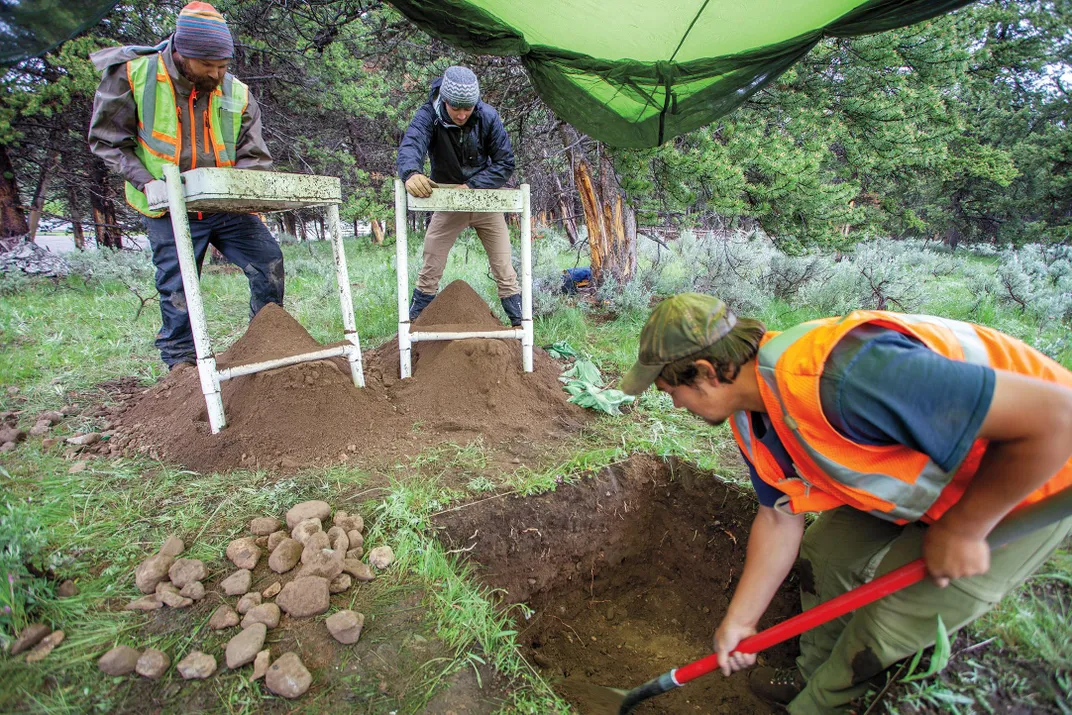
He came to Yellowstone because it’s the ideal place to study the archaeology of hunter-gatherers. It has never been farmed or logged, and most of its archaeological sites are intact. Morally, however, it’s a difficult place for him to work, because he “greatly laments” the removal of hunter-gatherers from the land and wishes they could come back. “There’s an irony to this,” he says. “We kicked Native Americans out of Yellowstone to make a park. Now we’re trying to find out how they lived here.”
In the oral traditions of the Crow, Shoshone, Blackfeet, Flathead, Bannock, Nez Perce and other tribes with ancient associations to Yellowstone, there is a rich store of material about the country they knew as “land of the geysers,” “land of the burning ground,” “the place of hot water,” “land of vapors” or “many smoke.” Much of this knowledge was gathered into a 2004 book, Restoring a Presence, by Peter Nabokov and Lawrence Loendorf, whose research was funded by the National Park Service.
Archaeological research supports and complements the tribal oral histories, and also reaches back further in time. In the view of Elaine Hale, who was the archaeologist at Yellowstone for 25 years, and has co-written a history of archaeology in the park, MacDonald “dives deeper than the rest.” Asked to elaborate, she says, “He uses a wider range of scientific techniques and equipment, like ground-penetrating radar and pollen analysis. He’s unique in the heart and thoughtfulness he brings to his work. He shares, promotes, communicates. He’s inspired so many students by bringing them to the park, including a lot of Native American students. For prehistoric archaeology in Yellowstone, no one is more well versed, and he’s reframed the whole approach.”
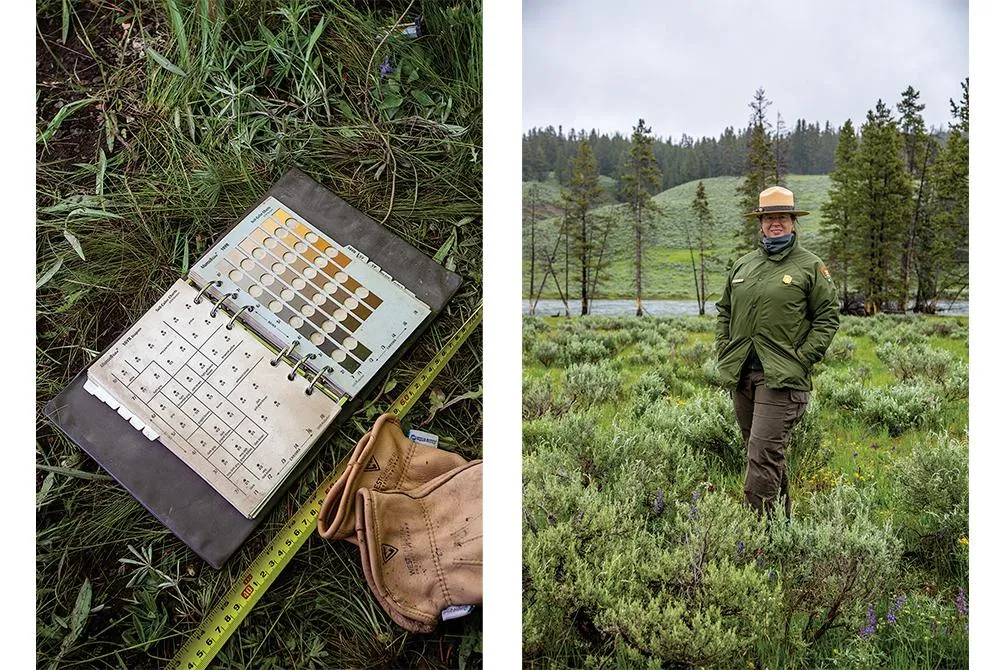
It was by measuring the decay of radioactive carbon in charcoal buried in the ground that MacDonald was able to date the lakeshore hearth as 6,000 years old, within an accuracy of 30 years. By testing blood and fat residues on 9,000-year-old stone knives and spear points, he found out that Cody people in Yellowstone primarily hunted bison and bear, but also elk, deer, rabbit and other species.
Microscopic remains of plants sifted from ancient campsites reveal what Native Americans were gathering thousands of years ago. Camas and bitterroot, both of which contain protein and grow in alpine meadows, were presumably vital to survival. Traces also have been detected of goosefoot, sunflower, sagebrush, wild onion, prickly pear cactus, balsamroot and various grasses, although hundreds of other species were probably gathered as well. In their campfires they were burning pine, spruce, ash, aspen, sagebrush and mistletoe.
At a site above the Yellowstone River, MacDonald’s crews excavated three stone circles marking the location of tepees. The circles were 400 years old and they inspired MacDonald to imagine a day in the existence of the family who had lived here. “I thought about them in late October, ” he says. “The father, uncle and son are hunting in the hills above the river, the women collecting driftwood from the riverbanks, everyone is nervously watching black storm clouds come over the mountains and realizing that it’s time to hurry home.”
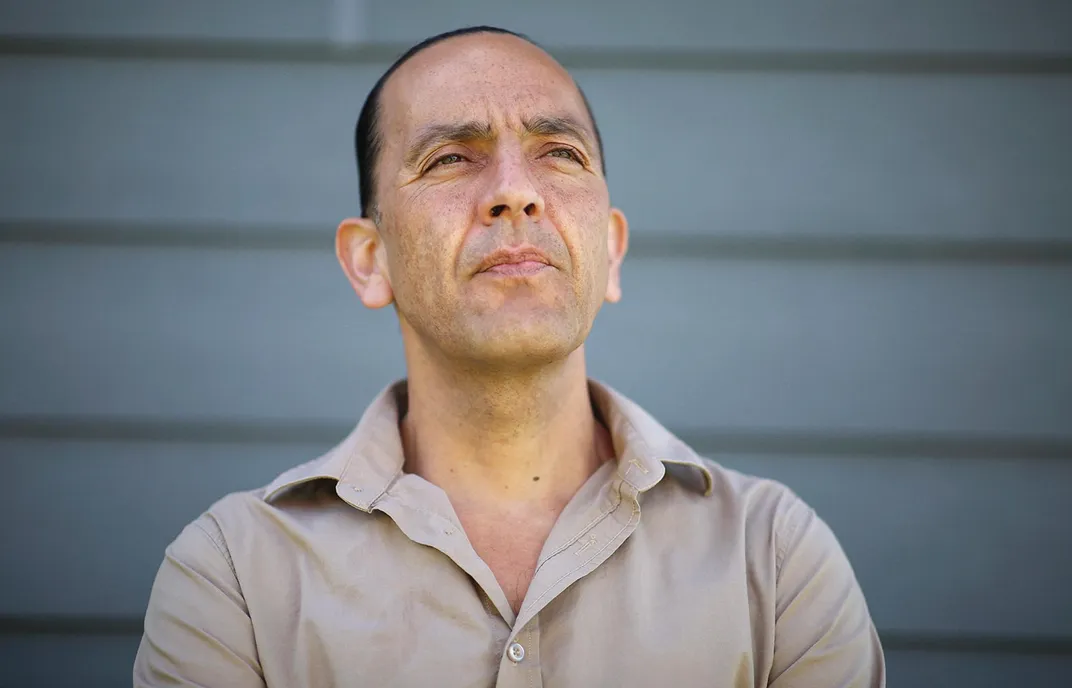
In MacDonald’s imagining, the father has killed a deer with his bow, and now, with the help of his brother and son, he quickly butchers it. They use large obsidian knives hafted by rabbit cordage to bone handles. The meat, which they pack into leather bags, will provide food to the extended family for a few days, and the hide will be made into leggings for the coming winter. Meanwhile, mother and her baby, grandmother, aunt and daughter walk along the river in a howling wind, followed by three wolf-like dogs. They surprise a rabbit, which daughter shoots with her bow. She skins the animal with an obsidian blade while the baby wails on her mother’s back from the bitter wind and driving snowflakes.
In the last ten days, this extended family band has raised and lowered its tepee five times. They are moving quickly off the high Yellowstone plateau toward their first winter camp by the river. Now, as the storm rages with full force, they raise the tepee again, father and son tying the poles together at the top while the women adjust the hides. Grandmother and aunt push rocks over the bottom edges of the hides, to block the wind and snow. The entire process takes about an hour. Everyone has cold feet and numb hands except the baby in its cradle board.
They enter the tepee and manage to get a fire going with the dry willow and sagebrush that the women packed in a bag. They lay down their gear and sleeping hides of bear and bison on the floor of the tepee, which is broad enough to accommodate all six adults and three children. The women unpack the rabbit meat and a variety of wild herbs and vegetables. They will eat well this evening and stay warm as the first winter storm of the year rages outside.
Four hundred years later, MacDonald’s crew excavated the fire pit in this tepee circle. They found tiny pieces of charcoal from the sagebrush in the fire, pieces of rabbit bone and plants from a stew, a stone scraping tool used to process deer hide into leggings, and a small pile of obsidian flakes. “I imagine that daughter made herself a new arrow point to replace the one she used to kill the rabbit,” says MacDonald. “They kept the fire going all night with sagebrush, and the sparks went up through the intercrossed poles high above them.”
A particular challenge for archaeologists in Yellowstone is the acidic soil, which has dissolved away most organic material in the archaeological record. They can’t determine what clothing looked like, for example, and they’ve found the remains of only a few human beings. One was a woman buried with a dog 2,000 years ago near the current location of the Fishing Bridge visitor center. When human remains are discovered, the park service calls in elders and council members from the 26 Native American tribes associated with Yellowstone, who decide the best course of action. The woman and her dog were reburied inside the park with a traditional ceremony.
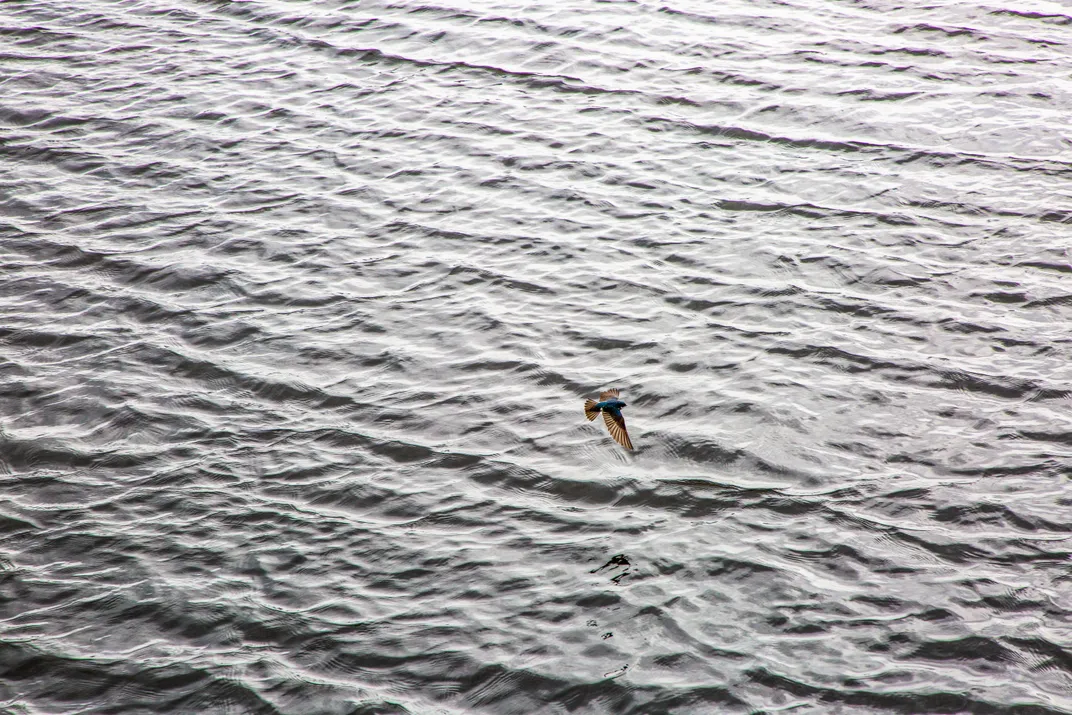
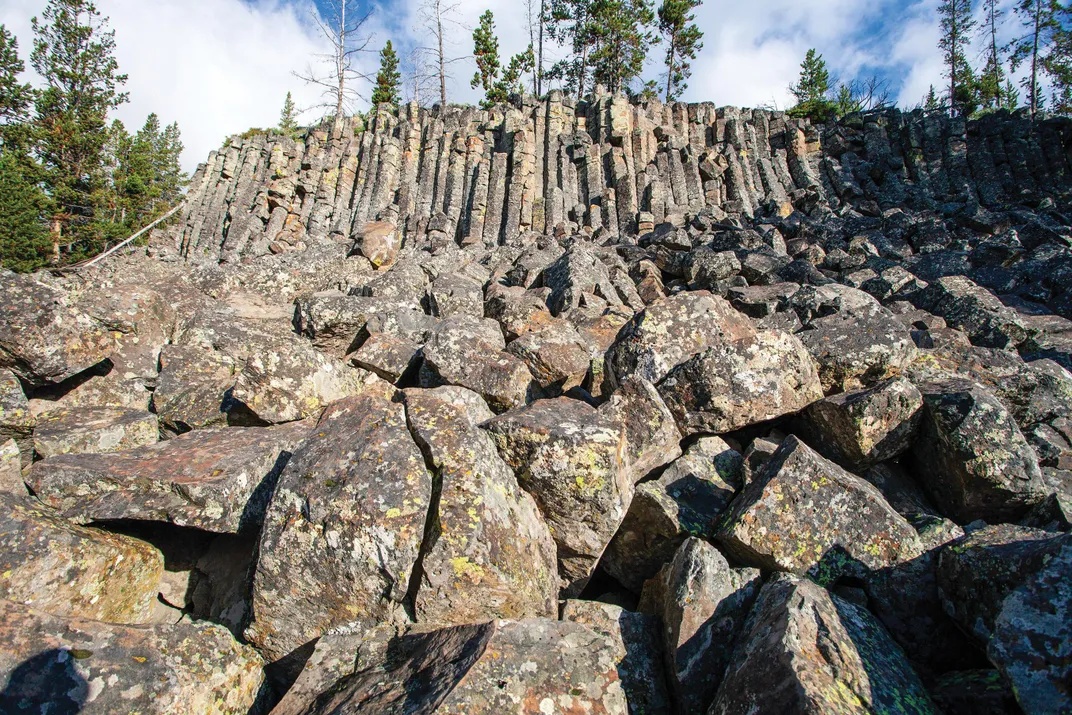
MacDonald thinks that the steep, forbidding mountains above the plateau are the real terra incognita for archaeologists. Yellowstone has 40 mountain peaks above 10,000 feet, and we know from Native American testimonies that they were important religious sites. People went there to pray and seek visions by fasting. For shelter from the wind, they built small structures of stacked rocks known as fasting beds. A few of these have been found in Yellowstone, on peaks with panoramic views, and MacDonald is confident that archaeologists will locate more.
There is no truth to the idea that Native Americans were afraid of the geysers and thermal features. Archaeologists have excavated hundreds of campsites near the geysers, and the Shoshone would soak the horns of bighorn sheep in the bubbling hot springs before reshaping them into beautiful and deadly bows. In general, Yellowstone’s geysers, mud pots, hot springs and fumaroles were regarded as places of great spiritual power. From interviews with Plenty Coups, Hunts to Die and other 19th-century Crow warriors, we know that a famous Crow shaman called the Fringe (born in 1820, he died from smallpox in the 1860s) would come to the big geysers in Yellowstone to heal wounded people and seek visions.
According to Hunts to Die, in his interview with the photographer-ethnographer Edward Curtis, the spirits in the geysers were afraid of people, rather than the other way around. But if you approached the spouting water in a pure and humble manner, some Native Americans believed, the spirits would reveal themselves and you could harness their powers.
* * *
Muted sunlight, filtering down through a thin layer of clouds, works a kind of magic at the Grand Canyon of the Yellowstone River. It saturates the colors on the canyon walls—yellows, reds, dark brown, orange, pink, white—and makes them glow with such intensity that the rocks appear to be lit from within. This is my first time seeing this famous canyon with its thundering waterfalls. While I struggle to make visual sense of it—how can the colors glow so brightly in this gray light?—MacDonald tells me about the artist Thomas Moran, whose 1872 painting of this scene, when displayed to legislators in Washington, D.C., was instrumental in getting Yellowstone designated as America’s national park.

But MacDonald’s main reason for bringing me to this famed American vista was to point out that “this was part of the original Crow reservation.” Shane Doyle, the Crow scholar at Montana State, later outlined the history. “The original Crow reservation in 1851 was over 30 million acres, and it included the entire eastern half of what would be Yellowstone. In 1868, prompted by a gold rush, that was reduced to eight million acres, and we lost all our land in Wyoming. We had no conflict with white settlers, we scouted for the U.S. Army, we tried to be allies to the whites, and we got treated like all the other tribes. Our reservation now is about two million acres.”
In 1872, when President Ulysses S. Grant signed 2.2 million acres of Wyoming, Montana and Idaho into existence as Yellowstone National Park, several different tribal groups were camped around Yellowstone Lake and along the Madison and Yellowstone rivers. The Crow still legally owned a strip of land in Montana along the Yellowstone River. Sheepeaters were hunting and gathering in the more remote areas and managed to stay inside the park for another seven years.
When the national park proposal was being debated in Washington, there had been little discussion about the “Indian” presence in Yellowstone and none about the land’s cultural importance to the tribes. They belonged on reservations, it was thought, where they could be instructed in English, Christianity, sedentary agriculture, individualism, capitalism and other Euro-American values. The park was created to protect the scenic wonders and wildlife from white hunters, prospectors, loggers and settlers. To encourage tourism, park officials and local promoters played down the presence of Native Americans and circulated the falsehood that they were afraid of the geysers. Anthropologist Matthew Sanger, a curator at the Smithsonian National Museum of the American Indian, stresses that conflicts with Native Americans were ongoing in the West at that time; Custer's defeat at the Little Big Horn was in 1876. “Creating a massive park in tribal lands was a distinct political act and it happened under a president who was fervently against Native peoples,” he says. “The park also represents the idea in Western philosophy that people are separate from nature, whereas Native American philosophy sees them as deeply intertwined.” On August 24, 1877, a party of nine visitors from Radersburg, Montana, were camped near Fountain Geyser, having made a glorious tour of the park. At 5 in the morning, as they were preparing breakfast, a group of Nez Perce warriors came into their camp, asking if they had seen soldiers and demanding food. Then more warriors appeared in the distance. The Radersburg party nervously packed up their wagons and started down the Firehole River, where they encountered some 800 Nez Perce and 2,000 horses. The nine tourists, having come to Yellowstone as sightseers, now found themselves in the thick of an armed conflict between the Nez Perce and the U.S. Army.
Faced with the prospect of becoming farmers on a reservation, these Nez Perce had chosen to flee their homelands in Oregon. They were being pursued by the Army, with skirmishes and battles along the way. Angry young warriors had killed a number of whites. The Nez Perce were hoping to find refuge with the Crows in the buffalo country of Wyoming and Montana, or with Sitting Bull in Canada, where they could continue to live their traditional life of hunting and gathering.
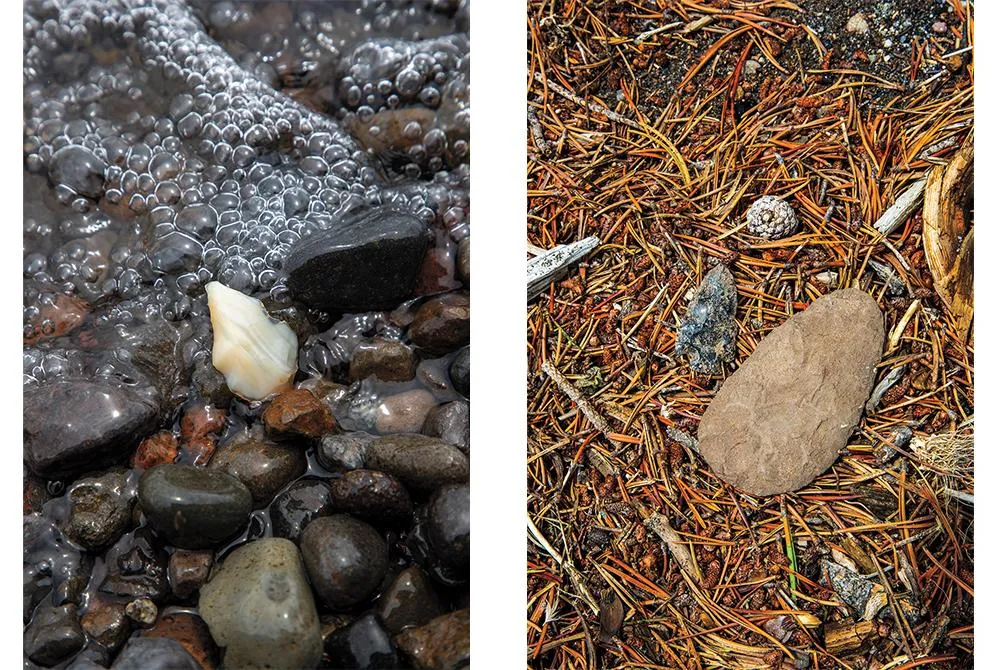
Contrary to what was reported in the newspapers at the time and has been taught to American schoolchildren ever since, the leader of the Nez Perce flight was not Chief Joseph. Joseph was a simple camp chief who made no military decisions and took charge of the Nez Perce only during their final surrender. As the great procession of warriors, elders, women, children, dogs and horses passed through Yellowstone, they were led by a half-white buffalo hunter known as Poker Joe. Against his instructions, a group of young warriors ended up looting the Radersburg party’s wagons and attacking the tourists.
In the park today road signs identify where the Nez Perce went next—across the Yellowstone River in the Hayden Valley, then to Yellowstone Lake, and up over what’s now called Dead Indian Pass in the northeastern corner of the park. Their old friends the Crows turned them away, so the Nez Perce went north toward Canada but were surrounded by the U.S. military in the Bears Paw Mountains of northern Montana. Joseph, the last chief standing, took over and, according to legend, he made a famous surrender speech: “From where the sun now stands, I will fight no more forever.”
But that was not the end of armed conflict inside the new park. The following year, 1878, a group of Bannock and Shoshone warriors fled into Yellowstone after a violent uprising in Idaho. The same U.S. Cavalry general who had forced the Nez Perce to surrender, Nelson Miles, defeated them within 20 miles of Dead Indian Pass.
To counteract the bad publicity generated by these two “Indian wars,” as they were described, park officials launched marketing campaigns that sought to erase the history of Native American presence in the park. Starting in 1886, the U.S. Cavalry patrolled the park for 32 years, to make tourists feel safer and discourage Native Americans from hunting and gathering in their old haunts.
In MacDonald’s opinion, the existence of Yellowstone National Park, and the United States of America, came at a “terrible cost” to Native Americans, and the least we can do today is acknowledge the truth. “When people look at Yellowstone, they should see a landscape rich with Native American history, not a pristine wilderness. They’re driving on roads that were Native American trails. They’re camping where people camped for thousands of years.”
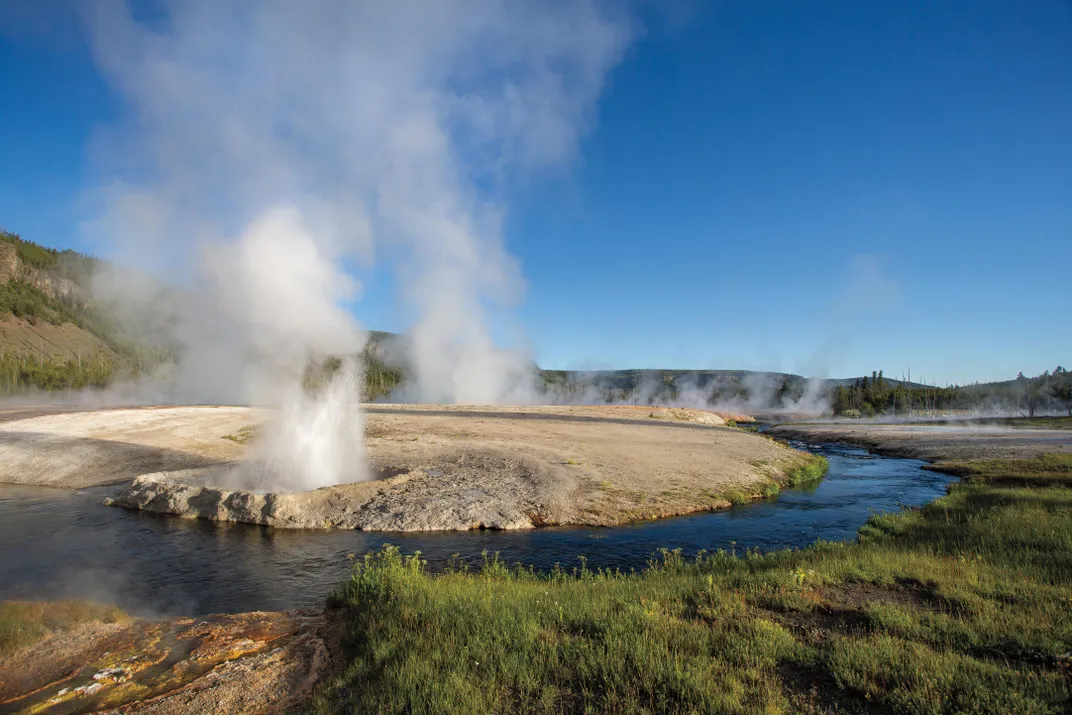
MacDonald has no Native American blood, but he regards the people who lived in Yellowstone for 11,000 years as something like ancestors. “We’re all descended from hunter-gatherers who lived in similar ways to the people here,” he says. “They were really successful at surviving in difficult conditions. We know this because we’re alive. If they hadn’t been so resourceful and successful, none of us would be here today.”
He would like to see more signs and exhibits about the park’s original inhabitants, first and foremost at Obsidian Cliff, but the park service is more concerned about protecting the site from possible looting. Shane Doyle has been advocating for a tepee village inside the park, where tribal college students could teach park visitors about the Native American history. “So far I’ve got nowhere,” Doyle says. “It might take a really long time, but I’m hopeful we’ll get there in the end. Surely, they can’t just keep pretending we were never there.”
Editor's note: An ealier version of this story said that two members of the Radersburg tourist party were killed by the Nez Perce in 1877. Two tourists were shot in the head, but they all survived the attack.
/https://tf-cmsv2-smithsonianmag-media.s3.amazonaws.com/filer/c7/27/c7279840-3160-4f05-ad77-743c41bffddd/opener_social_media.jpg)
/https://tf-cmsv2-smithsonianmag-media.s3.amazonaws.com/filer/1b/01/1b01602a-5320-49c0-87d3-8f8ba5ed0b44/opener.jpg)